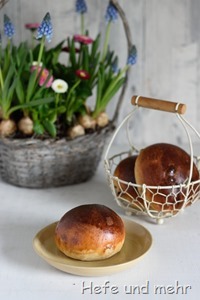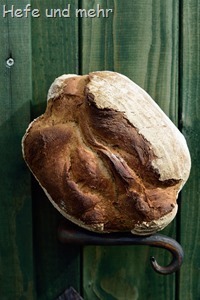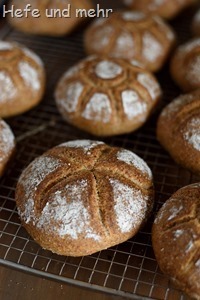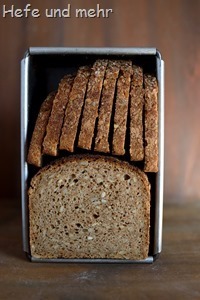Monthly Archives: March 2018
Heißewecken
 Heißewecken – sometimes called Hedewäggen, Hetwegge, Heiteweggen or Heetwich, too – are spiced raisin buns which are typical for North Germany. Their form vary from region to region, sometimes they are baked in bun shape, in others regions they are baked as flatbreads. They are baked traditionally in the feasting time between carnival and Easter and often served with warm milk and butter.
Heißewecken – sometimes called Hedewäggen, Hetwegge, Heiteweggen or Heetwich, too – are spiced raisin buns which are typical for North Germany. Their form vary from region to region, sometimes they are baked in bun shape, in others regions they are baked as flatbreads. They are baked traditionally in the feasting time between carnival and Easter and often served with warm milk and butter.
I have them on my list of regionals breads I want to bake for already one year. And before it is Easter again I finally managed to bake them. I chose the bun shape over the flatbread as I find the buns easier to eat for breakfast. But you can easily roll the dough to small flatbreads, too. Both forms are baked fast and hot which ensured a moist crumb.
I like the fine crumb and soft crust of this rolls very much. Cinnamon and Cardamom add a delicious deepness to the flavour and I ask myself why it took me so long to bake them …
Bergneustädter
 All the winter I did not make it to one of the bread baking days in our local history museum. It was due to different reasons: a lot of snow, a bad cold, our spontaneous weekend trip into the Ardennes…
All the winter I did not make it to one of the bread baking days in our local history museum. It was due to different reasons: a lot of snow, a bad cold, our spontaneous weekend trip into the Ardennes…
But last weekend I finally was back and it was so good to meet all the nice people there once again. And as every time I was enchanted by all the little details around the wood fired oven and took many photos.
To honour the museum I call the bread I baked this time “Bergneustädter” as the Museum is seated at the historical centrum of the little town Bergneustadt. It is a bread made with white wheat and rye flour. To keep the bread moist for a long time I added a bit of potato flakes and a little bit of butter, too. The roasted malt enhances the subtle smoke notes of the wood fired oven. For rising the bread adding my hyperactive sourdough would be enough. But as a wood fired oven waits for no one I kept on the secure side and added a bit of yeast to make the proofing better controllable. So the bread needed 60 min to be ready for baking, which is fits perfect in the time schedule I have in the museum.
Three Grain Bread (Variant 2)
Sometimes I have “phases” in which I concentrate on a special topic while baking. At the moment it is whole grain. Maybe the very cold or dark winter is the reason why I am craving for grains, I do not know. But it is as it is and so I played a bit with the recipe I posted two weeks ago. The result is a beginner friendly bread which needs not so much planning as works without preferment. To still archive a balanced flavour I opted for a mixture of buttermilk and a tiny bit of balsamico. The amount of balsamico has to be well balanced, as to much can cause a unwelcome stingy tartness. But carefully dosed it creates a flavour with reminders of sourdough taste.
For the rest, I keep the parameters: enough time for kneading and proofing, so the whole grain flour can soak up all liquid its need. And for a little change in the palate I switched wheat with emmer flour. But if you have no emmer flour at hand, it can be baked with spelt flour all along, too.
Buttery Whole Wheat Rolls
 The second recipe I got from my parents neighbour which needed a bit of work over was a recipe for whole grain rolls with milk and a good portion of butter. I liked the idea of this rolls instantly.
The second recipe I got from my parents neighbour which needed a bit of work over was a recipe for whole grain rolls with milk and a good portion of butter. I liked the idea of this rolls instantly.
I added poolish for more flavour and a water roux to make the dough more easy to handle. The other adjustment I made was concerning kneading and fermenting time. Kneading the dough until full gluten development is an important point here as a well developed dough keeps water much better. And as I told already last week, it is important that a whole grain dough gets enough time to soak up the liquid, too. This helps to improve the crumb as well as the shelf life. And in combination these all leads to a dough which is firm enough to get stemped with a roll stemp.
Beside of this I finetuned the recipe a bit, reducing the amount of yeast (once more) and adding an egg as lecithin source. This helps to create a fluffy roll with good volume and fine flavour. The buttery notes pair up very well with the nutty yet slightly bitter flavour of whole grain. These are rolls with potential for favourite rolls.

![Ostern[3] Ostern[3]](https://www.hefe-und-mehr.de/wp-content/uploads/2018/03/Ostern3_thumb.png)
